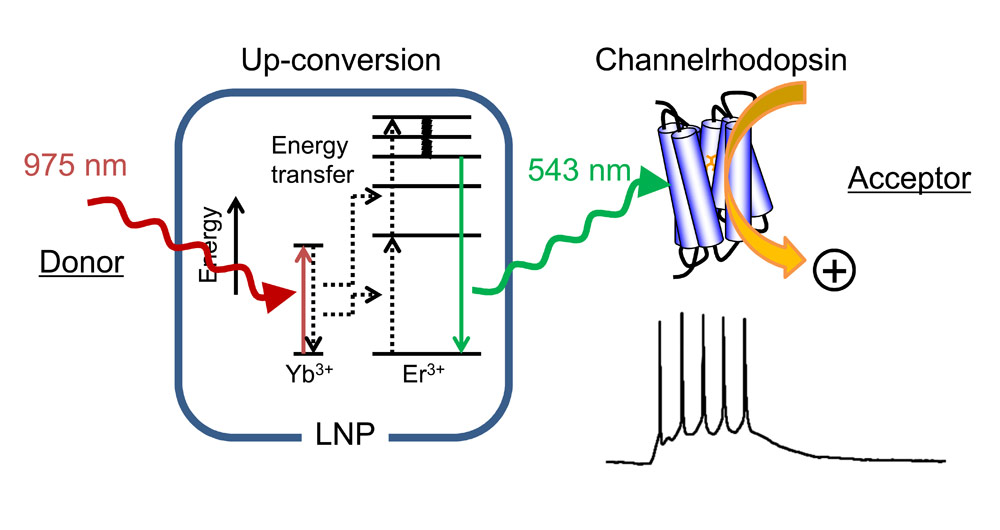Research Abstract
近赤外アップコンバージョン光遺伝学
Near-infrared (NIR) up-conversion optogenetics
2015年11月10日 Scientific Reports 5 : 16533 doi: 10.1038/srep16533

脳内の神経ネットワークの定量的理解や神経学的障害の治療のために、神経機能を非侵襲的に操作できるリモート・コントロール技術が、長らく求められていた。最近、チャネルロドプシン (ChR)-2 などの光活性化可能な生体分子を利用して、神経活動を光で操作することが可能になった。しかし、ChR2やその類縁分子の多くは可視光に反応するもので、可視光は生体組織を効率よく透過することができない。それに対して、近赤外(NIR; 波長650-1450 nm)光は、生体組織がこの帯域の光(いわゆる「イメージングの窓」)にほとんど透明なため、深くまで透過する。今回、希土類元素から成るランタニド・ナノ粒子(LNP)を、ChRを活性化する発光体として利用した。LNPは、低エネルギーのNIR光を吸収して高エネルギーの可視光を放出する(アップコンバージョン)。つまり、光ドナーのLNPとアクセプターのChRを組み合わせた新たな光遺伝学システムを構築した。NIRレーザー照射はLNPから可視光を放射させ、ChRを発現する周囲の細胞に、光応答性反応を誘発した。エネルギー効率の点において、このLNP-ChR系には、将来的に大幅な改善の余地がある。
Shoko Hososhima, Hideya Yuasa, Toru Ishizuka, Mohammad Razuanul Hoque, Takayuki Yamashita, Akihiro Yamanaka, Eriko Sugano, Hiroshi Tomita & Hiromu Yawo
Corresponding Author
Non-invasive remote control technologies designed to manipulate neural functions have been long-awaited for the comprehensive and quantitative understanding of neuronal network in the brain as well as for the therapy of neurological disorders. Recently, it has become possible for the neuronal activity to be optically manipulated using biological photo-reactive molecules such as channelrhodopsin (ChR)-2. However, ChR2 and its relatives are mostly reactive to visible light, which does not effectively penetrate through biological tissues. In contrast, near-infrared (NIR) light (650–1450 nm) penetrates deep into the tissues because biological systems are almost transparent to light within this so-called ‘imaging window’. Here we used lanthanide nanoparticles (LNPs), composed of rare-earth elements, as luminous bodies to activate ChRs since they absorb low-energy NIR light to emit high-energy visible light (up-conversion). Here, we created a new type of optogenetic system which consists of the donor LNPs and the acceptor ChRs. The NIR laser irradiation emitted visible light from LNPs, then induced the photo-reactive responses in the near-by cells that expressed ChRs. However, there remains room for large improvements in the energy efficiency of the LNP-ChR system.

